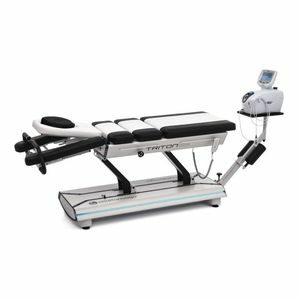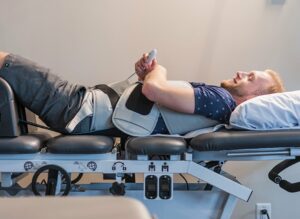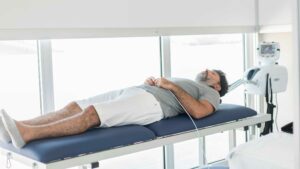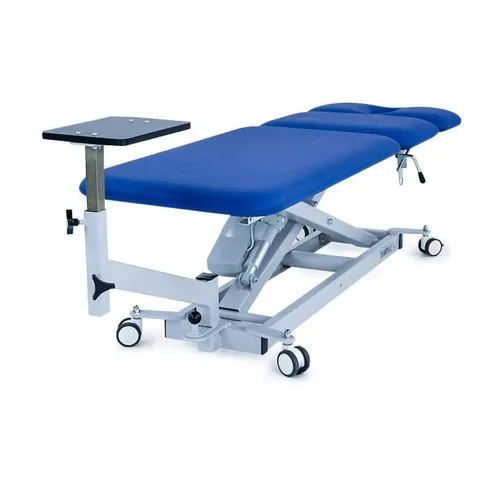Do you want to know everything there is to know about traction tables? If so, you’ve come to the right place! In this blog post, we will discuss what traction tables are, how they work, and the benefits they provide. We’ll also take a look at some of the top traction table brands on the market today. So whether you’re just getting started with traction therapy or you’re looking for an upgrade, read on for all the information you need!
Contents
What Is Traction Table?
 A traction table is described as a physical therapy device that uses therapeutic exercises and spinal manipulative therapy (SMT) to treat back pain and neck pain. The table is designed to provide a comfortable and secure environment for the patient while the therapist applies traction to the spine.
A traction table is described as a physical therapy device that uses therapeutic exercises and spinal manipulative therapy (SMT) to treat back pain and neck pain. The table is designed to provide a comfortable and secure environment for the patient while the therapist applies traction to the spine.
It is believed to work by gently stretching the spine, which can help to relieve pressure on the spinal discs and nerves. This type of therapy is often used in combination with other treatments, such as massage, chiropractic adjustments, and physical therapy exercises.
Traction tables come in a variety of shapes and sizes, and can be adjustable to accommodate different heights and weights. Some tables also have heat and/or electrical stimulation capabilities. So, if you’re considering this type of therapy for your back or neck pain, be sure to discuss all of your options with your doctor or physical therapist.
How Do They Work?
Now, the traction table is a medical device that’s been around for centuries, and it’s still in use today. Traction tables work by using counterweights and pulleys to stretch the spine. This decompresses the discs in the spine, which can help relieve pain. In addition, traction tables can also help improve the range of motion and flexibility.
Many people who suffer from back pain, herniated discs, and other spine-related issues can benefit from using a traction table. If you’re considering one for yourself, it’s important to understand how they work and what the benefits are.
These tables are also known as inversion tables, and they use your own body weight to provide traction. You strap yourself in and then slowly lower yourself upside down. As you hang there, the force of gravity pulls on your spine, which stretches the discs and relieves pressure.
Traction tables can be used for a variety of different purposes, so be sure to consult with your doctor or physical therapist to see if one is right for you.
Does A Traction Table Helps With Slipped Disc?
 Sometimes, people with herniated disks or other spinal problems can benefit from using a traction table.
Sometimes, people with herniated disks or other spinal problems can benefit from using a traction table.
The theory behind traction tables is that they can help relieve pressure on the spine by gently stretching the spine and decompressing the discs. This may provide some pain relief and allow the herniated disc to heal.
Because this is a non-surgical treatment, there is little risk involved. However, there is also no guarantee that traction will be effective. Some people may find relief from their symptoms while others may not.
If you’re considering using a traction table for your herniated disk, it’s important to discuss the potential risks and benefits with your doctor first. They will more likely be able to help you determine if this treatment is right for you.
What Are The Benefits Of Traction Table?
There are many benefits of traction table including:
- Reducing pain: This is the most common reason people use traction tables. By decompressing the spine and relieving pressure on the nerves, traction can help reduce or eliminate pain caused by conditions like herniated discs, degenerative disc disease, sciatica, and more.
- Improving flexibility: Stretching the muscles and ligaments around the spine can improve flexibility and range of motion. This can be beneficial for people who have stiffness and immobility due to age, injury, or sedentary lifestyles.
- Improving posture: Poor posture is a common cause of back pain. By aligning the spine and shoulders, traction can help improve your posture and alleviate pain.
- Relieving tension headaches: Tension headaches are often caused by muscle tension in the neck and shoulders. Traction can help stretch and relax these muscles, providing relief from headaches.
- Reducing stress: The relaxing effect of traction can also help reduce stress and anxiety.
The benefits of traction tables are various and can provide relief from many different types of pain. However, it is always best to consult with a doctor or physical therapist before starting any new treatment. Also, remember to use caution when first starting out and increase the intensity of traction gradually to avoid any injuries.
What Conditions It Can Help With?
 A traction table is generally used for various reasons. Some conditions that can be helped are:
A traction table is generally used for various reasons. Some conditions that can be helped are:
- Herniated or slipped discs
- Degenerative disc disease
- Facet joint syndrome
- Spinal stenosis
- Posterior facet syndrome
- Sciatica
These conditions are very painful and debilitating. This is where a traction table comes in to help. In fact, there are some minor or mild conditions that a traction table can help with as well. Some of these are:
- Mild backache
- Stiffness in the lower back or neck
- Sore muscles in the back or neck
- Headaches originating from the neck
Overall, many conditions are treatable with the use of a traction table. If you want to know more, please consult with a doctor or spine specialist. Because a professional can only give you the best and most accurate information.
Are There Any Concerns Or Limitations?
Well, this is something you’ll have to discuss with your doctor, but in general, traction tables are considered very safe. If you have a pre-existing condition like osteoporosis or disc degeneration, be sure to let your doctor know before starting traction therapy.
Other than that, there are no real concerns or limitations to using a traction table. Just be sure to follow your doctor’s guidance and instructions, and you should be fine. In addition, there are a few things that you should keep in mind while using traction tables:
- Don’t use it for more than the recommended time.
- Don’t increase the traction force beyond what’s comfortable.
- Don’t use it if you’re pregnant.
- Don’t use it if you have a herniated disc or other serious back condition.
Overall, you need to use common sense while using traction tables. If something doesn’t feel right, stop and consult with your doctor. With the right precautions, though, traction tables are an extremely effective and safe way to relieve back pain.
What Are The Examples Of Top Traction Tables?
 There are three primary types of traction tables: logarithmic, linear, and power.
There are three primary types of traction tables: logarithmic, linear, and power.
Logarithmic Traction Tables
A logarithmic table is one in which the input variable is multiplied by a constant to produce an output. For example, if the input variable is x and the constant is 10, then the output variable y would be equal to 10x. It is important to note that the output variable is not simply a linear function of the input variable.
Linear Traction Tables
A linear table is one in which the input variable is added to a constant to produce an output. For example, if the input variable is x and the constant is 10, then the output variable y would be equal to x+10. This type of traction table is used to find the y-intercept of a line.
To use a linear traction table, simply enter the values of x and y into the table and then find the value of y that corresponds to x=0. This will be the y-intercept.
Power Traction Tables
This is a type of table that is used to provide traction to the spine and other joints in the body. It is also known as a decompression table or a spinal traction table. The basic idea behind a traction table is to provide a gentle stretching force to the spine. This can help to relieve pressure on the discs and other joints in the back. It can also help to align the spine.
Traction tables come in many different shapes and sizes. Some are large and bulky, while others are small and portable. Some tables have electric motors that can be used to adjust the amount of force applied to the spine. Others require the user to manually adjust the traction.
Traction tables are often used in physical therapy, chiropractic offices, and massage clinics. They are also sometimes used at home for self-care. If you are considering using a traction table, it is important to talk to your doctor or physical therapist first. They can help you determine if traction is right for you and guide you in choosing the best type of table.
Conclusion
In conclusion, a traction table is a very versatile and effective tool that can be used for a variety of purposes. It is important to note that there are many different types of traction tables available on the market, so it is important to do your research in order to find the one that best suits your needs. If you are looking for an effective way to improve your overall health and well-being, then a traction table may be just what you need.
Physical Therapy help patients recover from pain. If you’re experiencing Back pain, Shoulder pain, Knee pain, Neck pain, Elbow pain, Hip pain, or Arthritis pain, a physical therapist at MantraCare can help: Book a physiotherapy session.


